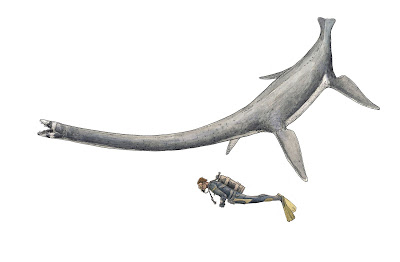 |
| Libonectes atlasense / Andy Chua Collection |
The collecting area is in the region of Drâa-Tafilalet. You may know Errachidia as Ksar Souk. It was renamed My Rachid, in honour of the Moroccan royal family. Libonectes is a genus of sauropterygian reptile belonging to the plesiosaurs. Specimens have been found in the Britton Formation of Texas and the Akrabou Formation of Morocco.
Sauropterygian reptiles were a diverse taxon of extinct aquatic reptiles that arose from terrestrial ancestors just after the Permian extinction event. They flourished during the Triassic then all but the plesiosaurs became extinct at the end of the Triassic — with the plesiosaurs dying out at the end of the Cretaceous.
The holotype of Libonectes atlasense is an almost complete skeleton from Upper Cretaceous (mid-Turonian) rocks of the Goulmima area in eastern Morocco. Sven Sachs from the Naturkunde-Museum Bielefeld and Benjamin P. Kear from Uppsala University co-authored a paper redescribing the elasmosaurid plesiosaurian Libonectes atlasense from the Upper Cretaceous of Morocco. They did an initial assessment of the specimen in 2005, proposing a generic referral based on stratigraphical contemporaneity with Libonectes morgani from the CenomanianeTuronian of Texas, U.S.A.
Relative differences in the profile of the premaxillary-maxillary tooth row, position of the external bony nasal opening, number of teeth and rostrad inclination of the mandibular symphysis, proportions of the axial neural arch, and number of cervical and pectoral vertebrae were used to distinguish between these species.
 |
| Libonectes Scale Drawing / Hyrotrioskjan |
Their work revealed that these reportedly distinct species-level fossils are in fact virtually indistinguishable in gross morphology.
Indeed, the only substantial difference occurs in relative prominence of the midline keel along the mandibular symphysis, which might be explained by intraspecific variation. Their observations permit an amendment to the published generic diagnosis of Libonectes with the confirmation of important states such as the likely presence of a pectoral bar, distocaudad expansion of the humerus, and an epipodial foramen.
And we see some entirely new features. Novel features include a prominent ‘prong-like’ ventral midline process on the coracoids and the development of a median pelvic bar that encloses a central fenestration. Their work shows that the composite remains of L. morgani thus constitute one of the most complete elasmosaurid skeletal hypodigms documented worldwide, and evidence a trans-Atlantic distribution for this apparently dispersive species during the early Late Cretaceous. The impressive mandible you see here is in the collection of Andy Chua.
Sachs, Sven and Kear, Benjamin. (2017). Redescription of the elasmosaurid plesiosaurian Libonectes atlasense from the Upper Cretaceous of Morocco. Cretaceous Research. 74. 205-222. 10.1016/j.cretres.2017.02.017.
Photo: Libonectes atlasense specimen, Andy Chua
Drawing By Hyrotrioskjan - Own work, CC BY-SA 4.0, https://commons.wikimedia.org/w/index.php?curid=57716018
